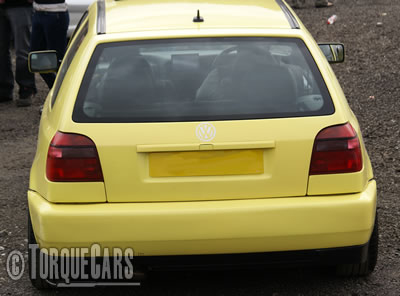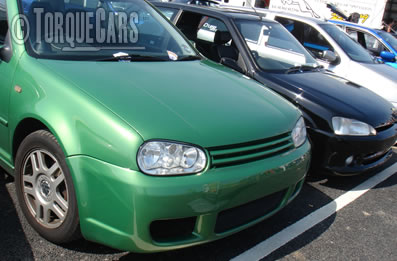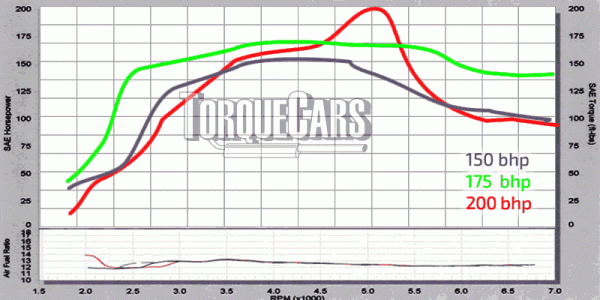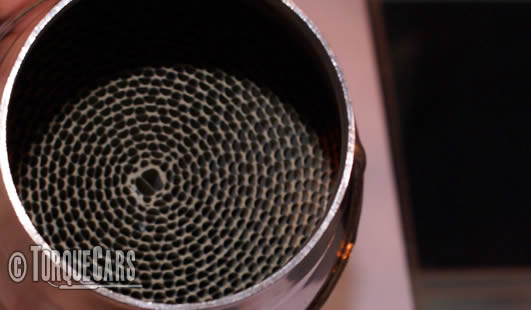Tuning the Golf.
"The original hot hatch gets even hotter!"
The Volkswagen Golf has been one of the most successful cars from Volkswagen.

The Golf is loved as a project car by many of our members and there is a large array of parts and tuning options for them.
Lets get a quick overview of the many revisions over the years to this popular car.
Then we shall look at the tuning options and best performance parts for your project and direct you to our detailed engine tuning guides.
Please watch our video introduction to VW Tuning.
First generation (Mk1/A1, Typ 17 1974–1983)
The original mk1 Golf was very responsive and still has a dedicated following today despite it's age. (Many owners say these cars improve with age as the 8v engines bed in and loosen up.) The GTi spawned a new generation of hot hatchback still very actively sought today.
Second generation (Mk2/A2, Typ 19E/1G 1983–1992)
Then came the mk2 Golf which was where the tuning scene started taking off and now we see 1.8T mk2 engine conversions and also the VR6 going in as well as owners capture the original essence of a mk1 GTi.
Third generation (Mk3/A3, Typ 1H/1E/1V 1991–1998)
mk3 Golfs were not fantastic cars, the GTi had lost it's magic so thankfully to address this there were plenty of aftermarket Golf tuning parts created allowing you to achieve the "GTi ideal" on your mk3 model.
Fourth generation (Mk4/A4, Typ 1J 1997–2005)
The MK4 (mkIV) and mk5 (mkV) Golfs shows VW dedication to the platform and a lot of criticisms levelled at the previous models were addressed. Golf MK4 Mods
Fifth generation (Mk5/A5, Typ 1K; 2006–2009)
The 5th generation won quite a few awards and we see a reappearance of the Rabbit moniker. Golf Mk5 Mods
Sixth generation (Mk6/A6, Typ 5K 2008–2012)
The mk6 & mk7 Golfs are a major leap forward and VW have once again come up with a stunningly fun car to drive and modify. Golf Mk6 Mods
Seventh generation (Mk7/MQB, Typ 5G 2012–2019
The Mk7 is based on the tnew MQB platform and engine options are back to top quality units, including a nice 1.5TFSi and 1.8TFSi unit. Mk7 Mods
Eighth generation (Mk8/MQB 2019-
A new Golf, on the previous platform, offers an evolution rather than revolution, but why change a working concept.

We now have many different revisions to the platform and the Golf remains a superb base for a tuning project thanks to all of the aftermarket tuning suppliers.
Golf Engines
We have detailed tuning guides for the following VAG group engines. (More will be added soon.)
-
- 1.4 1.5 TFSi tuning
- 1.4 TSi/TFSi/Twincharge tuning
- 1.8T engine Tuning
- 1.8 & 2.0 TFSi (mk1) Tuning
- 1.8 2.0 TFSi (ea888) Tuning
- 2.0 TFSi carbon issue & care guide
- 2.5tfsi tuning
- 3.0 V6 24v TFSI Tuning
- 2.8 V6 30 valve, 24 valve 3.0 V6 30v and 3.2 VR6 Tuning
- 3.6 VR6 Tuning
- 1.6 TDi tuning
- 1.9 TDi tuning
- 2.0 TDI 140-170 tuning
- 2.0 TDI tuning (EA188)
- 2.5 TDI tuning
- 2.7 & 3.0 TDI tuning
The engines pull well and the small relatively light body make it a fun car to drive. VW have continued to improve on the winning formula over the years with some fantastic engine and chassis set ups.
The early eighties 8 and 16 valve GTI engines were excellent and many remark that 8 valve engine actually improves with age. (A fact the Dyno seems to bear out!)
We have plenty of members in our forum with Golf tuning projects underway from engine swaps to the VR6 to 8 and 16 valve head conversions.
By the time the Mk3 and Mk4 were released there was something magical missing from the GTI. The handling was no longer as sharp and responsive as the early models.
It had become a run of the mill family car as VW looked to their profit margins rather than creating great cars. It was more of a lukewarm hatch than a hot hatch.
This didn't stop many of our members from improving it though. With an anti roll bar, a set of adjustable coil overs and low profile tyres along with a few other suspension tweaks you get a mk III/IV Golf every bit as much fun as the original.
Engine swaps are very popular with our members and we have seen everything from the recent 2.0Tfsi and the older 1.8T engines going into early golfs to VR6 engine conversions. You'll certainly get plenty of helpful advice and pointers on modified golfs in our forum.
Dropping in more powerful engines seemed the logical next step and we have seen successful conversions to the 1.8T and VR6 blocks. We have even heard of some Japanese engines being fitted with great success (much to the chagrin of Golf tuning enthusiasts).
The 2.0 TFSi is one of the best engines we've worked with and we've written a guide to this engine.
Engine modifications for the Golf
On the larger engines (1.8 and above) and those with turbos we recommend a full induction kit with a cold air feed. For smaller engines and the Diesel variants we would recommend a panel air filter made from a high flow material such as cotton gauze.
A fast road cam would raise the peak power band in most engines and after a tune/remap on a turbo model is one of the best tuning options out there for you.
The early 1.9TDi 1.8T and 2.0TDi are all very good engines, that prove to be reliable power plants for your modified Golf project.
The 2000 VAG 1.8T engine is one of the most tunable engines around and can be fairly easily tweaked to push out in excess of 300 BHP with no need for internal strengthening (but a larger turbo/injector upgrade and tune/remap would be essential to achieve this).
The later 2.0 TFSi is a real stormer of an engine and a worthy successor to the 1.8T and has a wide range of options for it. With just a tune/remap and modest other mods can put out significant amounts of power.
Please watch our video which covers the top VW Golf Tuning Mods. Be sure to keep up with our latest YouTube content and subscribe.
Best mods for your Golf
- Engine Tunes - Golf engine tuning/remapping offers the biggest gains compared to cost, aftermarket ECU upgrades, and Tuning boxes are all alternatives.
- Brake Upgrades - Stopping your Golf needs to be high on your agenda.
- Upgrades to turbochargers and superchargers - A New Turbo is the most dramatic method to increase your intakes air supply, allowing you to burn more fuel and make higher power. Typically one of the most costly mods it does provide the largest gains.
- Lighter flywheels - a lower weight flywheel will improve the engines free revving nature. In some cases flywheel lightening is not recommended for all Golf engines.
- Air Induction and Performance Exhausts - Be aware on their own these mods will NOT ADD HP for most setups, but they permit you to lift power after other modifications by losing a restriction.
- Fast road Camshafts are are often the best upgrade for an engine, but they must be setup by someone competent and it can sometimes be hard to find one but there is usually a local firm to regrind a stock cam for you.
- Internal engine mods - crank, pistons, conrods & compression ratio including balancing and blueprinting
- Golf Handling modifications - Replacing worn bushings and shocks dramatically improves Golf handling Poly Bushes and Coilovers are typically fitted to achieve this
Golf Tuning Stages
Typical stage 1 mods often include: Panel air filter, Sports exhaust, Alloy wheels, Lighter flywheel, Engine Tunes/Remapping, Suspension upgrade (drop 30-40mm).
Typical stage 2 mods often include: Power/Sport clutch, fuel pump upgrades, Fast road cam, high flow fuel injector, Ported and polished head.
Typical stage 3 mods often include: Engine balancing, Internal engine upgrades (pistons/head/valves), Adding or upgrading forced induction (turbo/supercharger), Sports gearbox, Competition cam.
You really need to keep as much low end torque as you can and aim to achieve a wide power band across the rev range rather than a narrow top end power hike.Many of our members have got power figures in excess of 200bhp with a straightforward ECU tune/remap with no detrimental effects.

Other particularly notable engines in the golf range was the the V6 4motion and the V6 R32 which produced 204 and 240 BHP respectively.
The Golf has a reputation for being a reliable car, and certainly holds its resale value well.
Check for a full service history when buying one though as the oil changes must be adhered to, especially on the turbo models.
There are many reports of sludge problems in the 1.8 models if oil changes are not carried out or the wrong grade is used see our 1.8T article for a comprehensive guide to this engine.
The TDI engines have improved considerably over the years, and the Golf 2.0 TDI engines represent one of the best economy to power ratios for an engine in current production.
Many consider the 1.9 TDi as the best diesel engine VW produced but the later 2.0TDi engines and modern fuel injection technology have raised the bar (sorry for that terrible pun!) and make superb projects to work on.
With a remap, power can reach 220 BHP (depending on the base spec), and you can still expect 50 plus MPG. Throw in a turbo upgrade and you can reach power figures of around 300bhp but you'll find traction an issue at these levels.
The mk5 Golf actually looks smaller than the previous model, but in actual fact has a slightly larger wheelbase. The wider hips seem to make the car seem smaller but dramatically improve the handling. Much of the handling criticisms leveled at its predecessor, the mk IV, have been redressed and the golf GTI is once again regarded as a driver's car.
Thankfully the Mk6 & 7 Golfs are another major leap forward and make a stunningly fun car to drive and modify.
Golf remapping
What makes OEM maps so bad?
Manufacturers do not want consumers to be inconvenienced by mechanical problems or fuel efficiency issues so they build a very wide margin for error.
Because various nations use different fuel grades and have differing degrees of unfavorable weather, fudge is required to keep all automobiles working properly internationally.
Each car's output varies optimally somewhere in the region of 10bhp depending on component quality and assembly. Instead of customizing timing maps for each car, they utilize a one-size-fits-all strategy so it works ok on all the Golfs rolling off the production line.
So if you are prepared to keep your Golf in top condition and will use only high quality fuels and compents you will find a tunes or remaps will dramatically increase engine power.
Plus, the typical TorqueCars reader will be upgrading components, so a tune/remap makes sense. Any engine upgrader should consider remapping.
All current turbocharged engines benefit from remaps, which give 20-30% more power. TorqueCars highly suggests engine tuning/remapping turbocharged automobiles and getting this done on a rolling road/Dyno to fully realize your power gains.
How much does it cost to run a tuned/remapped car?
Service your automobile more regularly, possibly decreasing the interval. A map optimized for high octane gasoline will need you to repair components that fail due to the added labor. Additional power puts more pressure on components like air flow sensors.
Months after a remap, an engine's weak areas resurface.
A tune/remap will usually reveal turbocharger and clutch issues. Also, turbos may fail, and critical components like pistons and bearings must be maintained.
NASP remaps?
A tune/remap will only add a few BHP without a turbo (10 percent is typical) so unless you've done lots of mods, particularly cams, pistons, increase compression, engine balance, air intake, exhaust, head work, bigger valves etc... a tune/remap is not really worth doing.
Turbocharged engine protection A tune/remap frequently adds boost from lower rpm, making the turbo operate quicker and hotter.
If you don't let the turbo cool, the oil may degrade, requiring an expensive turbo repair. Installing a turbo timer will also help cool the engine.
Be wary of the engine tuning/remapping companies peak Power Claims
Tuners have been known to create a power blip or spike to draw attention.

Note the image above, instead of giving power through the total torque curve the more impressive sounding 200bhp map (shown in red) only has a power blip, with poor perfromance everywhere else.
However, the green trace indicates a steady growth in power across the RPM range and although only 175bhp it is much better than the stock map and loads better than the 200hp map.
It also indicates peak power at 4000rpm, which is great for an engine that redlines at 7000rpm.
On a map, we want to see a nice smooth torque climb with no dips or troughs.
Results from Golf Tuning On Your Quarter Mile times
We are assuming a 1400kgs kerb weight, & Manual transmission
| Base power | Quarter Mile |
Tuned to |
Kerb Weight |
Quarter Mile |
| 115hp | 18.27 | 140hp | 1400kg | 17.50 |
| 140hp | 17.15 | 175hp | 1400kg | 15.95 |
| 150hp | 16.77 | 225hp | 1400kg | 14.71 |
| 170hp | 16.10 | 640hp | 1400kg | 10.98 |
| 550hp | 1200kg | 10.97 |
VW Golf Exhaust Upgrades
Only replace your exhaust if it is hindering your performance. Most factory exhausts will flow smoothly even with small power gains, but if you want to go much farther, you'll need a better flowing exhaust.
Exhausts developed for racing may help enhance engine airflow, although a wide exhaust may hamper flow velocity.
Aim for a thickness of 1.5-2.5 inches at all times. An aftermarket performance catalyst may be able to restore that lost power without the need for an illegal catalyst removal, allowing the car to remain legal to operate on public roads.

Because the higher size and surface area of a sports catalyst eliminates this constraint and enables the vehicle to operate as it would without a catalyst, it is akin to a test pipe alteration while still keeping your car street legal.
This implies that a sports catalyst boosts performance to the level expected without a catalyst while still keeping your vehicle street legal.
Because removing a catalyst is illegal in most locations and regions (and in others, you can't even replace a working catalyst), the alternative catless mod or catalyst removal should be considered an off-road only modification.
VW Golf Turbo upgrades and Mods
In recent years, the VAG group has added a variety of turbocharged engines to its vehicles, so let's have a look at these turbocharged engines, their differences, and your best upgrade alternatives. Read our detailed guide to VAG group turbos.
We also look at turbo power restrictions. You may push a turbo above its safe limits, but the turbo's lifetime will be diminished. Before the turbo fails, you will hear a whining or siren sound, followed by smoke.
At this time, you should try to replace it. The failure of a turbo may cause significant engine damage, particularly if a compressor fails.
Which turbos were fitted to the Golf?
K03, K03s, and K04 Comparison The K03 turbo was available from 1996 until 2000, when the K03s with more power took over.
Engines The K03 turbos are utilized on the 1.8T AGU engines. These engines use a MAF sensor and a cable-operated throttle with smaller injectors. The K03 turbos are utilized in AUM engines with MAF and MAP sensors.
These engines employ a better drive-by-wire throttle setup that increases reaction time, fuel efficiency, and performance. Stigan and BorgWarner are two major makers of K03 turbos.

Differences in KO3/KO3s
The number of blades is the most significant variation between turbos. The K03 has 11 and the K03s has 8.
The actuator that opens the turbine bypass valve is normally a 65N or 85N, however certain versions featured a 2 port actuator.
Because 180hp engines run higher boost, they need better quality actuators with larger opening force. Many hybrid turbo manufactures use a bigger compressor on the intake side to boost power.
hp The K03 has the least juice, so with correct add-ons, it can reach 190 horsepower. You may receive more, but the turbo will wear more quickly.
The K03s has more power than the K03. Most people get 215 horsepower with K03s, which is the safe limit. Exceptionally, this turbo has been touted to produce above 250 horsepower, so there is considerable leeway.
The K03s delivers a safe performance gain of at least 25 horsepower over a K03, more if you are willing to decrease turbo life or conduct additional maintenance.
What about the K04, how does this compare with the K03 K03s?
K04 Has Superior Performance Unlike the K03 and K03s, the K04 is bigger and produces superior output. With suitable hardware, the K04's performance can reach 350 horsepower, although the KO4's safe limitations are about 220hp. ]
Sizing: K03s and K03S turbos were smaller than K04. Despite having less power, they also took up less room than the K04 when installed.
New VAG Turbochargers
The IHI IS12, IS20, and IS38 turbochargers are the latest versions of the VAG K03, K03s, and K04 turbochargers. Audi and VW 1.8t MQB engines use the IS12 stock turbo, whereas the IS20 uses 2.0t MQB engines. IS38 Turbo - Why?
The IS38 is notable because it can generate 370 horsepower (with the proper add-ons).
Due to its great dependability, it is an IHI sought-after turbo. IS38 turbos benefits, In addition, it comes standard in certain perfromance models such as the VW Golf R, Arteon, S3 and TTS.
As a consequence, the IS38 is a great alternative for individuals wanting exceptional performance and durability.
The IS38 also has high turbo power at higher RPMs and is a bolt-on turbo.
Large selection of hybrid versions with better housing and impeller designs for increased performance.
A High-Performance IS12/IS20 Replacement
Many automobile enthusiasts have replaced the IS12 and IS20 turbo with the newer IS38. Turbo Upgrade
Why Turbocharge Your Car?
Here are some reasons why individuals replace or update their turbos: Upgrading a car's turbo is one of the most important power adders. Turbos lose performance with time, needing replacement. Newer turbos have additional add-on choices and take use of new technologies.
Best Golf Turbo Upgrades
We advise you to examine your provider carefully since there are many fake and low quality turbo units out there. Install a cheap turbo upgrade and you'll be doing it again in 6 months. Choosing a turbo with the following extra characteristics is also a good idea:
Compressor wheel in aluminum (light and strong) Vanes (Maximizes the boost available)
An actuator (sharpens throttle response and maximises your power gains) These tiny nuances may make or break a project.
Remapping IS REQUIRED AFTER A TURBO SWAP
Failure to do so might produce lean running or limp home mode with error codes. A factory ECU will only minimally reduce the fueling and you'll be squandering the chance.
If you need to replace the standard turbo, here are your options: K03 swaps If you wish to enhance your vehicle's factory K03 turbo, some options to consider are:
- SKU 40-30002 SG.
- SKU 40-30002 BW 53039880029 BorgWarner
TorqueCars strongly recommends BorgWarner turbos for your Golf project.
This turbocharger is often seen in or similar to: - 1997-2006 Audi A4 1.8 VW Passat 1.8 liter 1998-2004 2005 VW Passat 1.8L Gasoline K04 Rebuilds
Here are several choices for replacing the factory K04 turbo:
- SKU 40-30002 SH Stigan 847-1435
- This Stigan High-Performance New Turbocharger fits cars like: 1997-2006 Audi A4 1.8 VW Passat 1.8 liter 1998-2004
- SKU 40-30003 AW BorgWarner 53049500001
- This BorgWarner Airwerks Series High-Performance New Turbocharger is suitable for the following vehicles: 2000 Audi TT (all) 2000 VW Golf 1.8 liters Jetta 1.8
- IHI 2001 Genuine Turbocharger If your factory IHI turbocharger fails, you may replace it with the SKU 9VA02.
- This turbocharger should suit the following cars. Jetta Passat Golf Changing an Audi/VW turbo Although individuals are continually upgrading their turbos, switching a turbo is not as straightforward as it seems.
Swapping a VAG turbo to a different model is the same. While the procedure varies from automobile to car, several phases may include:
- New fuel injectors
- Changing the exhaust pipe diameter
- The gasoline pump
- A new booster controller
- Intercoolers or other cooling systems
- A wastegate change
- Using less restrictive catalysts
- Changing mufflers
On first glance, the following list may sound daunting, however the tasks required vary depending on the vehicle. Aside from the above measures, the engine compartment design and layout influence how difficult it is to transfer a turbo in from a different model.
The exhaust and intake pipes may need to be rerouted, and space may be limited.
Hybrid golf Turbos
Why Do Hybrid Super Chargers Exist? While Stigan, IHI, and BorgWarner all make turbochargers, many individuals feel the need to design hybrid turbochargers.
They combine high-performance elements from several manufacturers to create hybrid turbochargers. These hybrid turbochargers are designed to outperform OEM turbochargers.
Do Hybrid Turbos Work Like OEM Turbos?
To attain extreme performance, a hybrid turbo might have a single component changed or even the whole OEM turbo. Hybrid turbos are unusual in that they are not numbered. While these turbochargers seem like factory, the changed inner components promise dramatically improved performance.
Better Performance With Hybrid Turbos
Hybrid turbos outperform standard turbos in terms of reaction and performance because they combine the best of the finest elements.
A correctly constructed hybrid turbo provides increased pressure and flow while maintaining safe turbine speed.
This ensures the components' lifespan. With hybrid turbos, you get what you pay for. Stock turbos need many compromises, but the main benefit of hybrid turbos is that you get what you paid for.
Constraints
With Mods & a good REMAP K03s With a Stage 1 tune/remap (air filter, exhaust, bolt on modifications), should produce 210-220 horsepower.
Stage 2 Remapping (cat replacements, fuelling enhancements, and intercooler modifications) may generate 230-250 horsepower.
Remember that a Stage 2 engine tuning/remapping requires an intercooler to decrease the air temperature, otherwise you'll get a considerably lower power output.
REMAPPED K04
Stage 1 upgrades give the K04 turbo roughly 250-260 horsepower, although we've seen some with more.
An enhanced high-pressure fuel pump; an updated FMIC (front mount intercooler); high-quality fuel (98+ Ron); and a high-performance clutch (your OEM clutch will slip).
IHI IS38 Remapping;
With a Decat Exhaust* This turbo can be tuned/remapped to 370 horsepower, making it excellent for Audi Seat Skoda and VW aficionados! With remapping, the IS38 turbocharger for Audi and Volkswagen cars delivers best-in-class performance.
Golf Handling modifications
The body panels in the Golf are very substantial and solid so if you were going to perform weight reduction you could make a substantial saving with a carbon fibre bonnet and front wings.
The first Golf modification to perform is generally to sort the suspension. Lowering the car 30-40 millimetres and fitting stiffer springs will sharpen up the ride and your driver enjoyment of the car.
Many Golf owners uprate the handling of their cars with suspension upgrades as a priority, this will certainly increase your enjoyment of the car.
We found that most Golf factory suspension setups need tweaking, a few degrees of toe out for cornering or toe in for stability, -0.8 to 1.3, and a bit of negative camber will dramatically improve your cornering and handling.
Drop the car optimally somewhere in the region of 26mm - 39 mm and fit performance stiffer dampers, bigger drops will need other modifications in most instances.
Sourcing brakes from the VR, Audi RS3 and Porsche give an OEM solution to your braking deficiencies. Large discs and pads really do help add to the braking response of the Golf.
The front wheel drive versions will perform better if you fit a limited slip differential, or a semi locking diff as found on the A3 T Sport. Lower gear ratios will also improve acceleration.
Golf Alloy wheel upgrades.
As alloys are lighter they improve performance and they will help to cool the brake disks.
We'd like to point out although they can look cool on the Golf large alloy wheels will actually decrease your performance. The larger you go the lower your acceleration will be - this to the change in your effective final drive ratio.
With this in mind we would advise sticking to a maximum wheel size of 17 (or on the Mk5 onwards, 18 inches), although we know some of our members have gone larger than this with no problems it does compromise the handling.
Pay extra attention to the weight of the Rim and tyre, as this unsprung weight affects the handling considerably.
Please help us improve these tips by sending us your feedback in the comments box below. We love hearing about our website visitors projects, especially the mods done and which work best for you on your car.
Which helps us keep our guides and tips up to date helping others with their modified car projects. Your feedback and comments are used to keep this page up to date, and help improve the accuracy of these articles which are kept updated and constantly revised.
If you've enjoyed this page we would be very grateful if you could share a link to it on your favourite forums or on your social media profiles, it helps us keep going.
Join our friendly chat forum to meet our resident VAG enthusiasts, where you will have access to 1000's of car specific articles and will be able to get your tuning questions answered.
Please Check out my YouTube channel, we're regularly adding new content...
PLEASE HELP: I NEED YOUR DONATIONS TO COVER THE COSTS OF RUNNING THIS SITE AND KEEP IT RUNNING. I do not charge you to access this website and it saves most TorqueCars readers $100's each year - but we are NON PROFIT and not even covering our costs. To keep us running PLEASE Donate here
If you liked this page please share it with your friends, drop a link to it in your favourite forum or use the bookmarking options to save it to your social media profile.
Feedback - What do You Think?
Please use our forums if you wish to ask a tuning question, and please note we do not sell parts or services, we are just an online magazine.
Help us improve, leave a suggestion or tip
Please watch this video and subscribe to my YouTube channel.
One Response to “Golf tuning guide”

 Click to accept YouTube Cookies & Play.
Click to accept YouTube Cookies & Play.
can you change air filter to a k and n,on a vw 4motoin golf 2004 v6.lot of smoke out tail pipes even though just sailed mot.also condensacion inside car,is it just age or door rubbers need changing, thanks any help would be gratefull